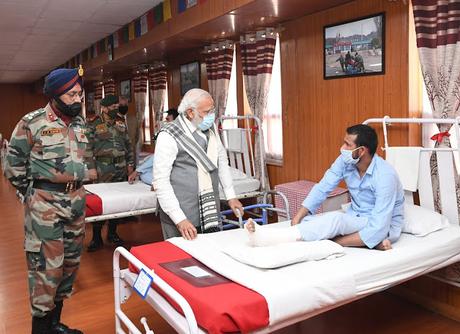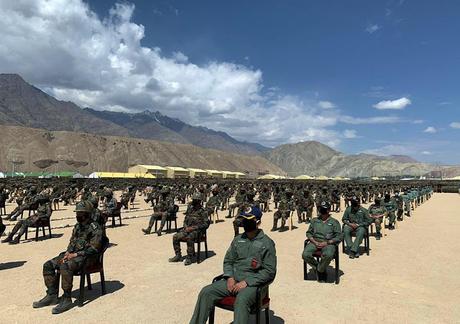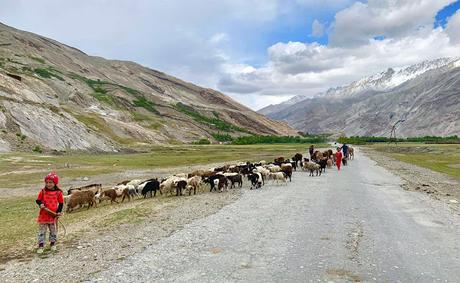The worst effect of Corona is rise in no. of armchair critics and cynics who on seeing every photo become experts in analysis.Just as we see WA experts in Medicine, Economics, Science, Technology, Astrophysics and more – some covidiots took to social media questioning the photos stating that it does not look like an hospital and the soldiers whom the Prime Minister was meeting did not look wounded... .. this was meme brigade of local political parties, commies and a MP of a National party.You cannot expect more from them for they can only equate scenes from movie – ‘ they know not history and God forgive them ‘ ! The whole World was surprised when news came out that our Prime Minister Shri Narendra Modiji had visited Ladakh, paid homage to soldiers, interacted with our soldiers and met those convalescing at hospitals .. ..

If Chinese media had written something that would have been understandable for it is always the order of Communist controlled Country to suppress all their information and write what they feel should be and not what has occurred ! – but sadly, there are cynics locally too whose bubble has been burst and torn by Army, yet they would not apologize nor write the truth. To what these extent these morons stoop – even questioning the Nation and army.
History is replete with China engaged in battles in every century of mankind. The Battle of Yangxia was the largest military engagement of the Xinhai Revolution and was fought from October 18-December 1, 1911, between the revolutionaries of the Wuchang Uprising and the loyalist armies of the Qing Dynasty. The battle was waged in Hankou and Hanyang, which along with Wuchang collectively form the tri-cities of Wuhan in central China. After heavy and bloody fighting, the stronger loyalist forces eventually prevailed by taking over both cities, but 41 days of determined resistance by the Revolutionary Army allowed the revolution to strengthen elsewhere as other provinces defied the Qing Dynasty. They have been constantly at war with their neighbours trying to expand and push their borders.The Sino-Soviet border conflict was a seven-month undeclared military conflict between the Soviet Union and China at the height of the Sino-Soviet split in 1969. The most serious of these border clashes, which brought the world's two largest communist states to the brink of war, occurred in March 1969 in the vicinity of Zhenbao (Damansky) Island on the Ussuri (Wusuli) River, near Manchuria. The conflict resulted in a ceasefire, with a return to the status quo. The Vietnam War was a conflict in Vietnam, Laos, and Cambodia that occurred and continued for decades from Nov 1955 to Apr 1975. It was officially fought between North Vietnam and South Vietnam. North Vietnam was supported by the Soviet Union, China, and other communist allies; South Vietnam was supported by the United States, South Korea, the Philippines, Australia, Thailand and other anti-communist allies. The war, considered a Cold War-era proxy war by some, lasted 19 years, with direct U.S. involvement ending in 1973, and included the Laotian Civil War and the Cambodian Civil War, which ended with all three countries becoming communist in 1975.
In 1962, the world’s two most populous countries went to war against one another in a pair of remote, mountainous border regions. In less than a month, China dealt India a defeat, driving Indian forces back on all fronts. Along with breaking hopes of political solidarity in the developing world, the war helped structure the politics of East and Southeast Asia for generations. Even today, as Indian and Chinese forces square off on the Doklam Plateau, the legacy of the 1962 resonates in both countries... .. that loss would ever remain in the minds of Indians and was a strategic failure by the then Prime Minister Mr Jawaharlal Nehru whose Congress party ruled the Nation for 6 decades. The Indian Army has issued a statement saying it is unfortunate that some people are casting aspersions on the treatment of Indian soldiers at the Leh hospital where PM Modi paid a visit on Friday. The Indian Army has said the armed forces are given the best possible treatment and the hall shown in the photos were converted into a ward due to the coronavirus crisis. “There have been malicious and unsubstantiated accusations in some quarters regarding the status of the facility visited by the Prime Minister Shri Narendra Modi during his visit to the General Hospital at Leh on July 03, 2020,” said the Indian Army said.
 Prime Minister Modi on
Friday visited Ladakh and spoke to the Indian Army, Air Force and ITBP
personnel posted in the border region. PM Modi also paid a visit to the injured
soldiers who fought Chinese troops in the Galwan Valley clash. Interacting with
them at the army hospital in Leh, PM Modi said the world is discussing that
India's brave soldiers have shown valour before "such powers". As
photographs of PM Modi's visit to the Leh facility surfaced, several people
took to Twitter and expressed doubt if the Leh facility visible in the photos
was a hospital at all.
As some said that the
facility shown in the photos are a conference hall and no hospital, the Indian
Army clarified that it is a training hall that was converted into a ward since
the Leh hospital became a designated Covid hospital. Slamming
critics, the Indian Army has said, “It is unfortunate that aspersions are being
cast on how our brave Armed Forces are treated. The Armed Forces give the best
possible treatment to their personnel.” “It is clarified that the said
facility is part of the Crisis Expansion capacity of 100 beds and is very much
part of the General Hospital complex,” said the Army.“The COVID-19 protocol had necessitated some
wards of the General Hospital to be converted into isolation facilities. Hence,
this hall which otherwise was normally used as a Training Audio Video Hall was
converted into a ward ever since the hospital was also designated as COVID
treatment hospital,” said the Army in its clarification on Saturday. It also
added, “The injured braves have been kept there since their arrival from Galwan
to ensure quarantine from COVID areas. The Chief of Army Staff General M M
Naravane and the Army Commander have also visited the injured braves in the
same location.”
But our War
and strategy experts who ruled the Nation for 6 decades and doing little were
quicksilver in finding out that it was not an hospital !! and even after their
lies are fully exposed, do not have the grace to erase and apologize for their
tweets and misinformed comments.
Exposing China has been a
challenge for the world. China never fails to surprise the world, particularly
India with deception in its policies, domestic or foreign. But for once, it was
rattled by the sheer political brilliance by a young Indian parliamentarian
Atal Bihari Vajpayee in 1965 – read this interesting report in India
Today.
One of the
excuses that China had used for a military confrontation with India in 1967 was
the charge that Indian soldiers had stolen its sheep and yaks. China made this
claim in August-September 1965. This was the time when
China was itching for another territorial expansion by appropriating Sikkim,
which was a kingdom under India's protection. It was also the time when India
was busy fighting infiltrators from Pakistan in Kashmir. Just three years ago,
India had suffered a humiliating defeat in war. China was again threatening to
"teach" another 1962-like lesson to India. However, as it turned out
in the end, China miscalculated India's preparedness this time around.
China wrote
a letter to the Indian government accusing Indian soldiers of stealing 800
sheep and 59 yaks. The Indian government obviously wrote back denying the
ludicrous charge but the response that Vajpayee, then a 42-year-old Jan Sangh
leader, gave left China fuming. Vajpayee arranged for a herd of around 800
sheep and drove them to the Chinese embassy in New Delhi in late September. The
sheep had placards tied saying, "Eat me but save the world." This
incensed China so much that it shot off another letter to the Lal Bahadur
Shastri government. China had called the protest by Vajpayee an
"insult" to the Chinese nation and alleged that it happened with the
backing of the Shastri government.
Prime Minister Modi on
Friday visited Ladakh and spoke to the Indian Army, Air Force and ITBP
personnel posted in the border region. PM Modi also paid a visit to the injured
soldiers who fought Chinese troops in the Galwan Valley clash. Interacting with
them at the army hospital in Leh, PM Modi said the world is discussing that
India's brave soldiers have shown valour before "such powers". As
photographs of PM Modi's visit to the Leh facility surfaced, several people
took to Twitter and expressed doubt if the Leh facility visible in the photos
was a hospital at all.
As some said that the
facility shown in the photos are a conference hall and no hospital, the Indian
Army clarified that it is a training hall that was converted into a ward since
the Leh hospital became a designated Covid hospital. Slamming
critics, the Indian Army has said, “It is unfortunate that aspersions are being
cast on how our brave Armed Forces are treated. The Armed Forces give the best
possible treatment to their personnel.” “It is clarified that the said
facility is part of the Crisis Expansion capacity of 100 beds and is very much
part of the General Hospital complex,” said the Army.“The COVID-19 protocol had necessitated some
wards of the General Hospital to be converted into isolation facilities. Hence,
this hall which otherwise was normally used as a Training Audio Video Hall was
converted into a ward ever since the hospital was also designated as COVID
treatment hospital,” said the Army in its clarification on Saturday. It also
added, “The injured braves have been kept there since their arrival from Galwan
to ensure quarantine from COVID areas. The Chief of Army Staff General M M
Naravane and the Army Commander have also visited the injured braves in the
same location.”
But our War
and strategy experts who ruled the Nation for 6 decades and doing little were
quicksilver in finding out that it was not an hospital !! and even after their
lies are fully exposed, do not have the grace to erase and apologize for their
tweets and misinformed comments.
Exposing China has been a
challenge for the world. China never fails to surprise the world, particularly
India with deception in its policies, domestic or foreign. But for once, it was
rattled by the sheer political brilliance by a young Indian parliamentarian
Atal Bihari Vajpayee in 1965 – read this interesting report in India
Today.
One of the
excuses that China had used for a military confrontation with India in 1967 was
the charge that Indian soldiers had stolen its sheep and yaks. China made this
claim in August-September 1965. This was the time when
China was itching for another territorial expansion by appropriating Sikkim,
which was a kingdom under India's protection. It was also the time when India
was busy fighting infiltrators from Pakistan in Kashmir. Just three years ago,
India had suffered a humiliating defeat in war. China was again threatening to
"teach" another 1962-like lesson to India. However, as it turned out
in the end, China miscalculated India's preparedness this time around.
China wrote
a letter to the Indian government accusing Indian soldiers of stealing 800
sheep and 59 yaks. The Indian government obviously wrote back denying the
ludicrous charge but the response that Vajpayee, then a 42-year-old Jan Sangh
leader, gave left China fuming. Vajpayee arranged for a herd of around 800
sheep and drove them to the Chinese embassy in New Delhi in late September. The
sheep had placards tied saying, "Eat me but save the world." This
incensed China so much that it shot off another letter to the Lal Bahadur
Shastri government. China had called the protest by Vajpayee an
"insult" to the Chinese nation and alleged that it happened with the
backing of the Shastri government.
 In its response, India
replied confirming that "some of the citizens of Delhi took in procession
about 800 sheep" but said, "The Government of India had nothing to do
with this demonstration. It was a spontaneous, peaceful and good-humoured
expression of the resentment of the citizens of Delhi against the Chinese
ultimatum and the threat of war against India on trumped-up and trivial
issues."
In its original complaint,
China had alleged that four Tibetan inhabitants had been kidnapped by the
Indian soldiers. India had responded saying, "Like other Tibetan refugees
these four people had come into India on their own volition and without our
permission and taken refuge in India. They are free to go back to Tibet at any
time if they desire to do so." China might actually have gotten infuriated
with the two Tibetan women, who escaped the eyes of Chinese authorities and
crossed over to India. They approached a police station on Indian side and
complained about atrocities committed by Chinese officials and soldiers. China
wanted India to hand over these women and some other Tibetans who had fled
seeking refuge in India.
On the question of
stealing of sheep, Indian response was: "Apropos the 800 sheep and 59 yaks
the Government of India have already given a reply in the clearest terms
possible. We know nothing of the yaks and as regards the sheep it is up to the
two herdsmen concerned to take them to Tibet if and when they choose to go back
to their homeland."
The entire
episode of Vajpayee mocking China's bullying tactic had become a talking point
during those weeks of tension leaving people in splits in public conversations.
Two years later, China did come to "teach" India a lesson but
returned with a bloody nose. The lesson that China learnt in 1967 ensured peace
on India-China border for several decades until Xi Jinping became the president
and resumed the salami slicing policy once again.
History is
always interesting !
With regards
– S. Sampathkumar
4.7.2020
In its response, India
replied confirming that "some of the citizens of Delhi took in procession
about 800 sheep" but said, "The Government of India had nothing to do
with this demonstration. It was a spontaneous, peaceful and good-humoured
expression of the resentment of the citizens of Delhi against the Chinese
ultimatum and the threat of war against India on trumped-up and trivial
issues."
In its original complaint,
China had alleged that four Tibetan inhabitants had been kidnapped by the
Indian soldiers. India had responded saying, "Like other Tibetan refugees
these four people had come into India on their own volition and without our
permission and taken refuge in India. They are free to go back to Tibet at any
time if they desire to do so." China might actually have gotten infuriated
with the two Tibetan women, who escaped the eyes of Chinese authorities and
crossed over to India. They approached a police station on Indian side and
complained about atrocities committed by Chinese officials and soldiers. China
wanted India to hand over these women and some other Tibetans who had fled
seeking refuge in India.
On the question of
stealing of sheep, Indian response was: "Apropos the 800 sheep and 59 yaks
the Government of India have already given a reply in the clearest terms
possible. We know nothing of the yaks and as regards the sheep it is up to the
two herdsmen concerned to take them to Tibet if and when they choose to go back
to their homeland."
The entire
episode of Vajpayee mocking China's bullying tactic had become a talking point
during those weeks of tension leaving people in splits in public conversations.
Two years later, China did come to "teach" India a lesson but
returned with a bloody nose. The lesson that China learnt in 1967 ensured peace
on India-China border for several decades until Xi Jinping became the president
and resumed the salami slicing policy once again.
History is
always interesting !
With regards
– S. Sampathkumar
4.7.2020

